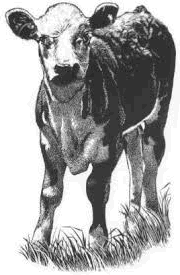

To send a message to an author, click on the author's name at the end of the article.
This Month in Ag Connection | Ag Connection - Other Issues Online

Fall is a time when spring-born calves are being weaned and decisions are being made about marketing the calves. Many producers choose to background calves after weaning and sell after the first of the year. To determine if this is a good financial decision, producers must know costs of gain and expected sale price, sale weight, and sale date.
There are many grain and grain by-products to choose from when developing cattle rations. Choice of ingredients is based on cost, feed storage facilities, rate of use, and desired animal performance.

Many producers, however, only look at the cost of individual feed ingredients per ton, particularly if higher moisture feeds from ethanol plants can be utilized. Recent price quotes from MU Extension By-Product Feed Price Listing have wet distiller's grains costing $17 per ton less at Missouri ethanol plants than modified distiller's grains. However, when calculating the cost of nutrients per pound of energy or protein on a dry matter basis, the current pricing structure favors the modified distillers' product, even though it is more expensive per ton.
When determining which ingredients to select, each needs to be evaluated in the total ration being fed, not by the individual cost of each ingredient. Additionally, many of these by-product feeds provide different positive aspects to the entire ration, so knowledge of the positive and negative attributes of different potential feed ingredients is important.
Another helpful calculation is feed cost per pound of gain. This is straightforward to determine and many ration programs can calculate this if feed ingredient costs are known. It is important to estimate the cost of all ration ingredients, including the forages. Be sure to include transportation and shrink costs when pricing ingredients, especially if buying semi-load lots of ingredients.

Ultimately, working with someone who can develop cost-effective rations designed to meet the performance goals of the livestock will pay off in the long run. Contact the MU Extension Field Specialist in Livestock for more information.
Source: Gene Schmitz, Field Specialist in Livestock
This Month in Ag Connection | Ag Connection - Other Issues Online
The All-America Selections Display Garden at the Adair County Extension Office has a beautiful sea of purple, yellow, orange, red, yellow and pink colors this summer. The plants have been easy to grow with little maintenance and have held up well with heat, rain, insect pressure and disease. Plants were mulched well at the time of planting, and rain has been plentiful. The public is welcome to visit the garden.
The following are a few of the plants that have been spectacular in the garden this summer.
2025 AAS winner, Black Forest Ruby Dahlia, is a "gem" of a plant featuring striking deep black foliage and abundant ruby-red flowers. Blooms range from semi-double to double, enhancing its diversity and charm. This is a seed-raised variety with pinnate leaves which has impressive overall durability. Plants are sturdy, do not flop open and are disease free all season long. The stems are long enough to be used as cutflowers.
2022 AAS winner Vanity Verbena, creates a pollinator paradise in the garden. Deep blue/purple flowers are 1-1.5 inches across and continue to attract butterflies and other insects day in and day out. Vanity prides itself on performing well in hot dry conditions while remaining a showy garden plant. The AAS judge stated: "This entry was my favorite in all of this season's entries!" Vanity reaches 2-3 feet in height, so plant it at the back of a bed with shorter plants in the front.
2024 AAS winner Sweetheart Kisses Verbena, is a low-growing wonder, praised by AAS judges for its vibrant red, rose, pink, and a hint of white blooms. It adds instant charm to any garden. Delicate, airy foliage forms a soft cushion, setting the stage for an explosion of color lasting all season long. Sweetheart Kisses thrives in sun-drenched days and dry spells. Plant this versatile plant in the ground, let it grow as a stunning groundcover, or fill containers with its cheerful blooms. Start from seed and in just 55 days, the garden will be buzzing with butterflies and bees, all drawn to its irresistible nectar. So, give the garden a kiss of summer magic with 'Sweetheart Kisses' Verbena. It is easy, eye-catching, and loved by pollinators- what more could a gardener ask for?
2022 AAS winner Purple Zebra tomato is a fun new addition to striped tomatoes, producing tomatoes rich with complex flavors and a moderately firm texture. Dark red fruits with green stripes and a deep mahogany red interior do not produce muddy coloration like other tomatoes of this type. The taste is sweet and acidic leaning to sweet. Overall, this tomato has a better taste and thinner skin than comparisons with excellent disease resistance. Judges said this is a very marketable fruit for farmers' market growers. It has high disease resistance to ToMV (tomato mosaic virus), Verticillium Wilt, Fusarium Wilt, Leaf Mold, Late Blight, and intermediate resistance to TSWV (tomato spotted wilt virus).
2023 AAS winner San Joaquin Jalapeno will make gardening so much easier! This is a determinate jalapeno that sets most of its fruit in a short window so there is a generous (~50 fruits per plant) number of fruits ready all at the same time. Perfect for canning, pickling, and making roasted stuffed jalapenos for a crowd. If not needed for a while, these peppers remain firm until ready to harvest. Judges loved the flavor of the thick-walled fruits that have just a hint of heat at 2500-6000 Scoville units. Leave on the plant longer for a beautiful red, and still delicious, jalapeno.
Source: Jennifer Schutter, Field Specialist in Horticulture
This Month in Ag Connection | Ag Connection - Other Issues Online
Though a more common and serious pest issue in the southern United States, Missouri is seeing an increase in the population numbers of stink bugs in crop fields. Stink bugs pose an economically significant threat to soybean and corn production acres in the state of Missouri, if threshold is reached within a field. In Missouri soybean production fields, the threshold is eight stink bugs captured per 20 sweeps, and in seed bean fields, the spray threshold is four per 20 sweeps. In Missouri corn production fields, recommended spray thresholds are one stink bug per four plants (25% infestation) before tasseling and one stink bug per two plants (50% infestation) after tasseling up to dough stage. Looking at 10 plants in 10 locations (100 plants total) in the field can help make this assessment in corn. It is worth noting that an edge effect will be observed with stink bugs, so it is important to not only scout field margins, but also at least 100 feet into a field. When scouting stink bugs and making spray decisions, only count nymphs that are .25 inches long or more and adults. No-till fields, late planted fields, and fields bordered by timber can favor stink bug populations.
The three main stink bug species observed in Missouri corn and soybean production fields include the green stink bug (Chinavia hilaris), the brown stink bug (Euschistus servus), and the one-spotted stink bug (Euschistus variolarius). These insects all have a shield shaped body, with adult green stink bugs being a light green and .5 to .75 inches long. Green stink bug nymphs are oval shaped and measure between .1 to .5 inches long and display a mostly black with orange marking color pattern in early instar stages, and as they grow into later instar stages, begin to display a mostly green with black and orange markings coloration pattern.
Brown stink bug and one spotted stink bug adults are similar in size (.4 to.6 inches long) and appearance. There are key differences to differentiate between adults, these include the presence of a dot on the tip of the abdomen of the male one spotted stink bug. One spotted stink bugs also have more pointed shoulders (anterolateral margins of the pronotum) than the brown stink bug species. Brown stink bugs and one spotted stink bug nymphs are identical in the first two instars and have a general yellowish-brown coloration and a size range from .06 to .4 inches in size.
As the brown and one spotted stink bug nymphs mature into the third through fifth instar stages, the one spotted stink bug nymph will display a white band on the under (ventral) side of the head that extends to or nearly to the eyes. The white banding is much less pronounced on the third through fifth instar nymphs of the brown stink bug species. Antennal coloration differences also develop for both species during their fourth and fifth instar, with the last two antennal segments of the one spotted stinks bug's antenna being brownish black, and the brown stink bugs last two antennal segments being reddish brown.
Although these three stink bugs are unique individual species, spray thresholds are based on the combined complex. Green stink bugs typically favor soybeans while brown and one spotted stink bugs favor corn, however all three species will prey upon both crops. A field entomological survey conducted by MU Extension in 2024 on producer soybean acres observed approximately 70% of captured stink bug insects belonging to the green stink bug species.
The threat to corn is greatest during the first two weeks after emergence when the stink bugs can often be seen feeding roughly an inch above the ground surface (check the whole plant). Scouting during this early growth stage for stink bugs and the damage (dead plants, stunted plants, and tillering plants within the same row in a stair step appearance) lines up well timing wise with checks for cutworm damage. Later vegetative stage (V5 or later) feeding during the early season while leaves are still in the whorl will produce a rough oblong shothole type appearance with yellowed margins. These yellow margins are caused by the injection of digestive enzymes excreted in the saliva during feeding and are key in diagnosing stink bug feeding damage from other insect feeding damage such as that which is produced from billbugs.
Feeding during early reproductive stages can result in misshaped "banana ears" in extreme cases, but in lighter feeding damage scenarios, missing or deformed kernels can be observed. Later feeding damage can occur through late milk or early dent stage, resulting in deformed kernels and holes produced from feeding. Later reproductive stage scouting for stink bugs can be conducted while checking for other insect feeding damage such as Japanese beetles. While stink bugs can feed on beans at various stages of growth, stink bugs begin to colonize soybean fields is at the start of flowering and this is when scouting should begin.
In soybeans, female stink bugs will begin to move in on field margins at the start of flowering and lay eggs typically on the underside of leaves. Depending upon weather conditions, it can take one to three weeks for nymphs to hatch and 23 days to two months to go from an egg to an adult stink bug. One to three generations of stink bugs will be produced each year, depending on species and weather. After the initial first three instars, stink bug fourth and fifth instar nymphs and adults will begin to disperse throughout the field and feed. This described behavior is why it is important to scout margins as well as central regions of soybean fields. Ideally, soybeans should be checked weekly.
These feeding stages are what is scouted for and what produces damage in soybeans. Stink bug populations will increase during soybean reproductive stages and typically peak around pod development and seed fill. Stink bugs feed on blooms, pods, and developing seeds. Feeding damage results in reductions in seed quantity and quality. Feeding damage earlier in seed fill can result in flat pods due to aborted seeds, as well as undersized or deformed seeds. Later seed fill stage feeding can result in shriveled and discolored seeds. Seed germination rate is also impacted, which can be very detrimental for seed bean production. Feeding damage can also cause abnormal production of leaflets and pods and a delay in plant maturity, commonly known as "green bean effect or green stem syndrome", causing issues at harvest time.
Broad spectrum insecticides are generally effective against stink bugs. It has been observed that of the pyrethroid insecticides, bifenthrin is most effective and allows for the greatest amount of active ingredient application of any pyrethroid. Neonicotinoids such as thiamethoxam, dinotefuran, and imidacloprid also show promise for stink bug control, and can be found in seed treatments and foliar sprays. Brown stink bugs have shown slightly less susceptibility to pyrethroid insecticides than green stink bugs, depending on where these products are sprayed in the country, possibly due to genetic variation in stink bug populations in different regions of the United States.
Before making any spray application, always refer to the label first when making insecticide selections. Scouting will aid in protecting beneficial insects. Egg parasitoids in combination with other predatory insects can destroy over half a fields population of stink bugs eggs alone. Overapplication of broad-spectrum insecticides will harm beneficial insects as equally as the harmful insect species and can promote the development of resistance traits to chemical control options. Chemical control is often the most recommended option as it is the most effective option, typically.
Source: Nick Wesslak, Field Specialist in Agronomy
This Month in Ag Connection | Ag Connection - Other Issues Online
Morgan County - Sept. 4-6
Versailles, MO
For details call 573-378-5822 ext. 3
Linn County - Sept. 30 - Oct. 2
Linneus, MO
For details call 660-895-5123
Or email tatev@missouri.edu
This Month in Ag Connection | Ag Connection - Other Issues Online
Research, Extension and Education Centers Field Days
Sept. 18 - Southwest, Mount Vernon, MO
Oct. 4 - South Farm, Columbia, MO
Oct. 18 - Chestnut Roast, Horticulture and Agroforestry Farm, New Franklin, MO
Publishing Information
Ag Connection is published monthly for Northeast and Central areas of Missouri producers and is supported by the University of Missouri Extension, the Missouri Agricultural Experiment Station, and the MU College of Agriculture, Food and Natural Resources. Managing Editor: Mary Sobba.